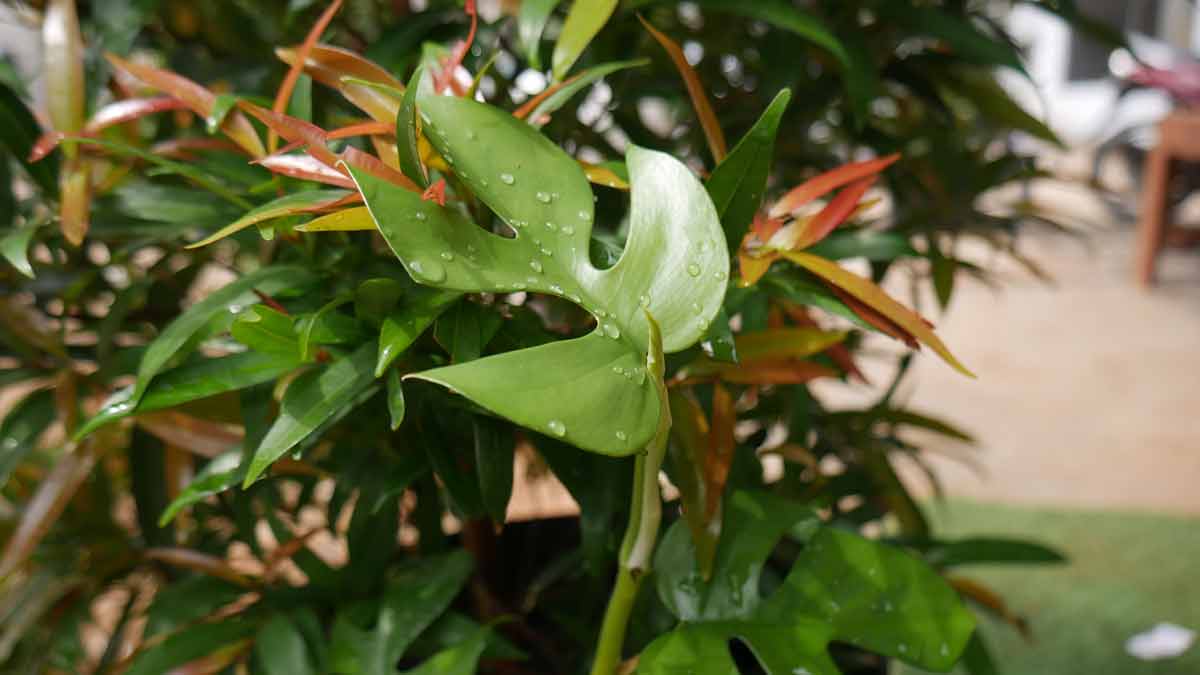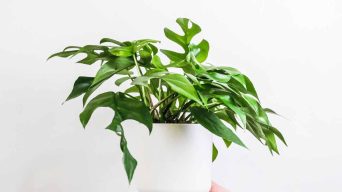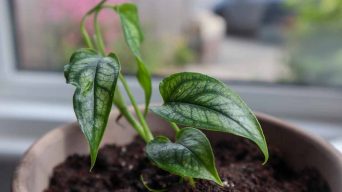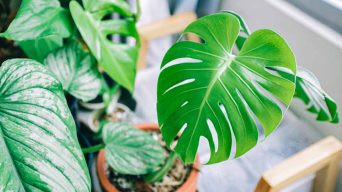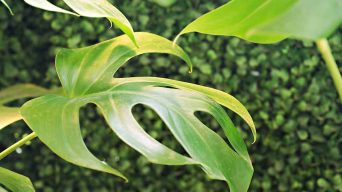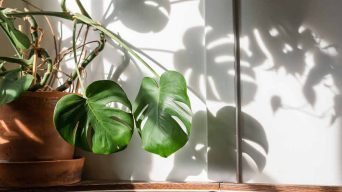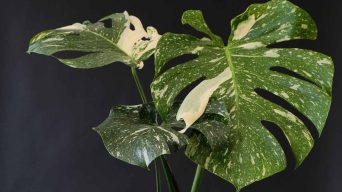Welcome to the ultimate guide for Mini Monstera care, where we unravel everything you need to know about Rhaphidophora tetrasperma!
This rare plant gem is gaining popularity among plant enthusiasts and interior decorators thanks to its striking split leaves and easy-care nature.
Keep reading as we explore the ins and outs of nurturing this tropical delight — from light requirements and soil preferences to potential pitfalls that may arise along your botanical journey with the Mini Monstera.
Overview Of Rhaphidophora Tetrasperma (Mini Monstera)
| Family: | Araceae |
| Genus: | Rhaphidophora |
| Botanical Name: | Rhaphidophora tetrasperma |
| Common Names: | Mini Monstera, Monstera Minima, Ginny Philodendron, Mini Split-Leaf |
| Origin: | Southern Thailand and Malaysia |
| USDA Hardiness Zones: | 9b – 12 |
| Size: | 4 – 12 feet tall (1.22 – 3.5 m) and 18 – 24 inches wide (45 – 61 cm) |
| Sun Exposure: | Bright indirect sunlight |
| Water Needs: | Constantly moist but not soggy |
| Soil Type: | Well-draining soil |
| Temperature: | Between 55°F to 85°F (12 to 29°C) |
| Humidity Levels: | 60-70% |
Rhaphidophora Tetrasperma is a fascinating plant that has captured the attention of many plant enthusiasts.
Known for its resemblance to its cousin, Monstera Deliciosa, this tropical vine has become a popular household item due to its ease of care and unique appearance.
Appearance
The Rhaphidophora Tetrasperma, or the Mini Monstera, is a striking plant due to its appearance.
It features glossy green leaves adorned with distinctive split patterns resembling those of the larger monstera species like Monstera Deliciosa.
However, what sets this tropical beauty apart from its bigger relatives is its smaller size and intricate fenestrations on each leaf.
Mini Monstera plants are true attention-grabbers in any indoor space, thanks to their unique foliage that grows on slender vines.
The perforated look gives it an exotic charm that adds life and vibrancy to any room.
Their leaves can grow up to 6 inches long – significantly smaller than those of a full-sized Monstera Deliciosa, which could span over 24 inches wide!
This makes them a perfect choice for houseplant enthusiasts who want the elegance of a monstera without committing extensive space for it.
As your Mini Monstera matures, you’ll also notice aerial roots developing along with stems.
These Aerial roots provide visual appeal and aid in providing support as they readily climb toward available surfaces or structures around them.
Growth Habits
Rhaphidophora Tetrasperma boasts a unique climbing growth habit that sets it apart from other houseplants.
Like its relative Monstera Deliciosa, this tropical plant features stunning split leaves with an interesting pattern of holes and slits.
As the plant matures, these leaves can grow larger and exhibit even more intricate fenestrations.
However, compared to the massive Monstera Deliciosa, Mini Monstera remains relatively compact – perfect for indoor spaces.
One important aspect of mini monstera care is providing adequate support for the plant’s aerial roots as it grows vertically.
A moss pole or trellis can encourage proper growth and maintain its natural elegance while preventing damage to your walls or furniture.
This fast-growing tropical beauty thrives under bright indirect light conditions.
However, if given ample sunlight and appropriate watering and soil requirements, it can grow at an impressive rate during its growing season.
Incorporating Rhaphidophora Tetrasperma into your indoor plant collection will bring a touch of exotic flair while showcasing your plant enthusiast skills through proper mini monstera care practices.
How To Care For Mini Monstera
To ensure your Mini Monstera thrives, it’s important to understand its light, watering, soil, temperature, and humidity needs.
Read on for expert tips on how to care for your tropical vine!
Sunlight And Light Requirements
Mini Monstera plants require a good amount of light to grow well, but they can’t tolerate direct sunlight.
Place your plant in medium to bright indirect light or near an east- or west-facing window to keep it healthy.
Avoid placing it near windows that receive direct sunlight, which can cause its leaves to scorch and damage the plant.
If your Mini Monstera is not getting enough light, you may see smaller leaves than usual or a lack of growth.
A simple way to ensure adequate lighting is by keeping the plant close to a window that receives morning sun only.
However, avoid prolonged exposure when the sun rises higher in the sky.
Remember that Monstera needs bright light but not direct sunshine for optimal growth indoors.
So find an area with abundant natural lighting—where you’ll enjoy its beauty without harming it.
Watering Needs
When it comes to watering your Mini Monstera plant, there are a few things you should keep in mind.
Firstly, overwatering is the leading cause of problems for this particular plant, so it’s important to avoid giving it too much water.
On the other hand, if you underwater your Monstera for a while, that’s generally better than letting it sit in soaked soil.
It’s also crucial to use well-draining soil that retains moisture when watering your Mini Monstera.
Watering regularly can encourage your Monstera to grow faster and help your plant thrive.
However, ensure not to let the soil become too wet – aim to water your Monstera when the top two inches of soil feel dry to the touch.
By keeping these tips in mind and monitoring how much water your plant needs based on its requirements, you’ll be able to keep your Mini Monstera happy and healthy!
Soil Requirements
Regarding soil requirements for the Mini Monstera, it’s important to choose loose and rich soil that allows for proper drainage.
The ideal mix consists of equal parts peat moss, orchid bark, and perlite or sand.
This ensures that the roots have enough air circulation and prevents water from sitting stagnantly at the bottom of the pot.
It’s important to avoid using heavy soils that can lead to root rot – this is a common issue with houseplants.
If you notice any issues with your plant, such as yellowing leaves or stunted growth, it may be due to poor soil quality.
Repotting into new nutrient-rich soil can often solve these problems and give your Mini Monstera a new lease on life!
Remember not to damage its roots while repotting so as not to shock them too much!
Optimal Temperature And Humidity Levels
Maintaining optimal temperature and humidity levels is one of the most critical factors in caring for your mini monstera plant.
Rhaphidophora tetrasperma thrives in warm, humid environments similar to its native tropical habitat.
The ideal temperature range for this plant is between 55°F to 85°F (12 to 29°C), with consistent warmth being key to promoting healthy growth.
In addition, humidity levels should be around 60-70%, which can be challenging to achieve indoors.
If you live in a dry climate or have central heating or air conditioning that dries out the air, consider using a humidifier or placing a tray of water next to your plant.
Mist spraying can also help raise humidity levels around the leaves and stems of your mini Monstera.
Remember that extreme heat or cold temperatures can damage and even kill these sensitive plants, so it’s important not to expose them to harsh environmental conditions.
Proper temperature and humidity conditions for your mini Monstera will ensure its overall health and vitality as it grows into a beautiful addition to your indoor garden collection.
Fertilizing And Nutrient Requirements
To keep your Mini Monstera healthy and thriving, giving them the necessary nutrients is crucial.
Fertilization of Rhaphidophora Tetrasperma should be done once or twice a month during the growing season using a balanced liquid fertilizer.
During winter, however, it’s best to skip fertilizing as the plant goes into a dormant period.
These plants benefit from regular feeding during the growing season using very mild liquid fertilizers designed for house plants.
You can opt for slow-release granular fertilizers lasting up to six months in soils with proper drainage.
Additionally, you can use organic matter such as compost when repotting to provide extra nutrients that will help fuel growth.
By providing your Monstera adequate fertilization and monitoring nutrient requirements, you’ll ensure your Mini Monstera has everything they need to thrive indoors.
Potting And Repotting Requirements
Rhaphidophora Tetrasperma requires a light, airy, and nutrient-rich soil for optimal growth.
Choose a container with good drainage holes when potting your Mini Monstera plant.
Indoor potting soil can be mixed with coco coir, fine moss, or perlite to improve drainage.
Adding a layer of orchid bark at the bottom of the pot can help aerate the roots when repotting.
Regarding repotting requirements, Rhaphidophora tetrasperma should be transplanted every 1-2 years, depending on its growth rate and size.
Signs it may need repotting include root-bound conditions where roots grow through drainage holes or become tightly packed in their current pot.
It is important not to disturb the delicate root system too much during repotting as it can cause damage that could impact its health and growth in the future.
To ensure successful transplanting, prepare fresh well-draining soil beforehand and carefully remove rhizomes from their old container while ensuring there’s no damage done.
Once you’ve placed them into their new container (make sure it has plenty of space), gently backfill with soil around each stem until an inch or two below the rim remains unfilled — this will allow for proper watering later on without spillovers!
Finally, water thoroughly so all parts receive enough moisture before setting your newly potted plants aside somewhere bright but away from direct sunlight until they’ve had time to settle into their new homes!
Pruning And Maintenance Tips
Pruning and maintenance are crucial for keeping your Rhaphidophora tetrasperma healthy and growing beautifully.
Here are some tips to help you maintain your Mini Monstera plant:
- Keep an eye out for yellowing or dying leaves: Regularly remove any yellow or dying leaves from your plant, as this can encourage better growing conditions.
- Use a sharp blade for pruning: When pruning, use a sharp blade to cut the stem below a node, preferably one with aerial roots. This will promote new growth and prevent the plant from becoming too leggy.
- Remove debris: Regularly remove any fallen debris or dead leaves from around the plant to prevent pests and diseases from taking hold.
Remember these tips, and your mini Monstera will be thriving soon!
Common Issues And Their Solutions
One common issue with Mini Monstera plants is root rot, which can be prevented by ensuring proper drainage and not overwatering.
Yellowing leaves are another problem that can be caused by either underwatering or overwatering, but this is easily fixed by adjusting watering habits.
In this comprehensive guide, learn more about troubleshooting common issues with your Rhaphidophora tetrasperma plant.
1. Root Rot Prevention And Treatment
Root rot is a common issue with Rhaphidophora tetrasperma plants, but it can be prevented and treated with proper care.
Here are some tips for preventing and treating root rot in mini monstera plants:
- Use well-draining soil: Ensure that the soil used for planting is well-drained and allows excess water to escape easily.
- Terra-cotta pots: Potting your Rhaphidophora Tetrasperma plant in a terra-cotta pot helps facilitate drainage by allowing excess water to evaporate through the porous walls of the pot.
- Proper watering: Avoid overwatering your plant, which can lead to soggy roots—only water when the top inch of soil is dry to the touch.
- Adjust watering schedule during winter months: In winter, adjust your watering schedule since plant growth slows down and needs less water.
- Repot every two years: Repot your Rhaphidophora Tetrasperma plant every two years or when you notice that it has outgrown its current pot or soil is becoming compacted.
- Check for white roots: Occasionally, check for healthy white roots poking out of fresh soil, indicating good drainage and healthy growing conditions.
- Treat root rot early on: If you detect root rot early on, remove damaged parts from the root system while ensuring you do not remove too many at a time which could weaken the plant too much.
Following these tips can prevent root rot in your Mini Monstera plant.
Treat it before it causes too much damage when you detect root rot symptoms, such as yellow leaves or stunted growth.
Dealing With Yellowing Leaves
If you notice yellowing leaves on your plant, it could indicate a few different issues.
Here are some possible causes and solutions to help you get your plant back to health:
- Overwatering: If the soil is consistently wet or soggy, it can cause the leaves to turn yellow and become limp before falling off. Make sure to let the top inch of soil dry out before watering again, and ensure that there is proper drainage in your pot.
- Underwatering: On the other hand, if your Mini Monstera isn’t getting enough water, the leaves can also turn yellow and drop off. Check the soil regularly and water when the top layer feels dry.
- Lack of humidity: Rhaphidophora Tetrasperma prefers a humid environment. If the air is too dry, it can cause leaf tips to turn brown before ultimately yellowing and falling off. Consider using a humidifier or placing a water tray near your plant to increase the humidity.
- Light stress: Direct sunlight or exposure to bright indirect light for extended periods can lead to yellowing leaves. Move your Mini Monstera somewhere with lower light levels or provide some shade during the hottest parts of the day.
- Nutrient deficiencies: A lack of essential nutrients such as nitrogen, magnesium, or iron may cause yellowing from old bottom-up leaves to new growths.
Remember that some older leaves will naturally yellow and fall off as part of its life cycle.
But suppose you notice multiple or sudden leaf drops or consistent yellowing leaves despite adjustments in care.
In that case, it could indicate a more severe issue, such as root rot or pest infestation, requiring immediate treatment or removal.
Identifying And Treating Pests And Diseases
The Rhaphidophora Tetrasperma, like other houseplants, is susceptible to pests and diseases that can hinder its growth and development.
Here are some common pests and diseases associated with the plant, their symptoms, and how to treat them:
- Mealybugs: These pests are white cotton-like insects that attach themselves to stems and undersides of leaves feeding on sap from plants causing yellow spots on foliage, which leads to death if left untreated – they can be treated with rubbing alcohol mixed in water sprayed lightly onto the infested areas.
- Spider Mites: These pests are tiny insects that live on the undersides of leaves, causing damage by puncturing plant cells to feed on the juices. Symptoms include yellowing of leaves and webbing between leaves. Treat spider mites by washing the plant thoroughly with water and dish soap, or insecticidal soap.
- Fungus Gnats: These small bugs thrive in moist soil, causing root rot and stunted plant growth. Symptoms include small flies hovering around the potting mix or soil surface when watering plants. To treat fungus gnats, allow the soil to dry out between waterings or use a mosquito dunk.
- Mosaic Virus: This virus causes distorted growth patterns on leaves of infected plants, including yellowing patches or streaks resembling mosaic patterns and stunted growth. Unfortunately, there is no cure for mosaic virus once it infects your plant; remove affected plant parts immediately to prevent spread.
Paying attention to these symptoms early on and using appropriate treatments or prevention methods can keep your Mini Monstera healthy and thriving for years.
Winter Care For Mini Monstera
During winter, adjusting watering and fertilizing routines for Mini Monstera plants and providing adequate temperature and lighting conditions is important.
Read on about how to care for your beloved plant during the colder months!
Temperature And Lighting Needs
The Mini Monstera needs bright, indirect light to thrive.
It does not tolerate direct sunlight well and will suffer from leaf burn if exposed to too much sun.
If you’re growing your Mini Monstera indoors, place it near a window with plenty of natural light.
However, ensure that the direct sunlight doesn’t hit the leaves directly.
Regarding temperature requirements, Rhaphidophora Tetrasperma prefers temperatures between 70-85°F (21-29°C).
However, it can tolerate lower temperatures, up to 60°F (16°C) during winter.
Avoid exposing your plant to sudden changes in temperature, as this can cause stress and damage the leaves.
If you live in an area with cold winters, consider providing extra lighting and heat for your Mini Monstera using grow lights or a heating mat.
Watering And Fertilizing Adjustments
When watering your mini Monstera, it’s important to remember that the amount of water needed will vary depending on factors such as humidity levels and temperature.
During the growing season, you should water your plant when the top inch of soil feels dry.
During winter, Mini Monstera enters a period of dormancy and won’t need as much water as it does during warmer months.
Additionally, you should avoid fertilizing during this time since growth slows down significantly.
Instead, wait until spring before resuming regular fertilization with a balanced liquid fertilizer applied once a month throughout the active growing period.
Regular fertilizing is essential to proper Mini Monstera care, but don’t overdo it.
While they appreciate occasional feeding, too much fertilizer can damage roots and reduce overall health.
A diluted liquid plant fertilizer is applied only once a month during spring and summer is necessary for healthy growth and thriving foliage.
Tips For Growing Healthy Mini Monstera Plants
To grow healthy Mini Monstera plants, it is important to select a well-draining pot and place it in an area with bright, indirect light while providing proper support, like a moss pole or trellis, and ensure adequate ventilation.
Pot Selection And Placement
Choosing the right pot and placement for your Mini Monstera plant is crucial to its growth and survival.
Firstly, choosing a well-draining pot that allows excess water to flow away from the roots is essential.
Mini Monstera plants prefer moist soil, but overwatering can lead to root rot, resulting in stunted growth or even death.
Secondly, it’s vital to consider the placement of your Mini Monstera in terms of lighting and support.
These plants thrive in bright indirect light, so placing them near a window with filtered sunlight is ideal.
Alternatively, you can use artificial grow lights if natural lighting is insufficient.
Lastly, a support system like a moss pole or trellis helps your Mini Monstera grow upright without getting too heavy on top-heavy leaves or vines.
It’s important not to place your plant too close or far away from poles since aerial roots need something sturdy for their grip.
By following these simple tips on pot selection and placement for your mini monstera plant, you can create an optimal environment that promotes healthy growth and thriving foliage throughout the year!
Providing Proper Support
Mini Monstera plants are climbers that require adequate support to grow and thrive.
One way to provide support is by staking your Monstera using a moss pole, which mimics the plant’s natural habitat as it grows up trees in tropical forests.
Moss poles help the Mini Monstera climb up and produce larger leaves, preventing them from flopping over or getting tangled.
Another support option is placing the plant near a trellis or other vertical structure.
This allows the Mini Monstera to climb and expand while providing an attractive backdrop for your indoor garden. Just make sure that any supporting structure is stable enough to hold the weight of the plant as it grows.
Proper support ensures that your Mini Monstera remains healthy, vibrant, and aesthetically pleasing for years.
By taking care of this small detail, you can enjoy watching your beautiful houseplant flourish into a stunning living art!
Ensuring Adequate Ventilation
To ensure your mini Monstera’s proper growth and development, it’s important to provide adequate ventilation.
This means ensuring there is enough air circulation around the plant.
Stagnant air can lead to problems like fungal growth, damaging your plant.
There are a few ways to ensure adequate ventilation for your mini Monstera.
One way is by placing the plant in an area with good airflow, away from closed windows or doors that could block circulation.
You can also use fans or open windows to help improve air movement in the room.
Another way to improve ventilation is using well-draining soil and pots with drainage holes.
Excess moisture in the soil can create a humid environment that promotes fungal growth and harms roots, so ensure excess water can escape through drainage holes.
Following these tips for adequate ventilation will help prevent mold or root rot issues while supporting healthy growth for your Mini Monstera plant!
Displaying And Decorating With Mini Monstera Plants
Mini Monstera plants are an excellent option for enthusiasts who love decorating their living spaces.
These charming and adaptable plants can be displayed in various ways, adding a touch of tropical flair to any room.
One popular way to display Mini Monstera plants is by training them up moss poles or trellises.
This helps the vines grow upward, making the plant more compact and easier to manage.
Trailing them up walls behind sofas or beds can create a dramatic effect that adds depth and character to your home.
Another creative way to display mini monstera plants is in hanging baskets or shelves.
Suspended above eye level, these clever displays offer a unique perspective of the plant’s leaves and stems while freeing up valuable floor space.
If you want something even more unconventional, consider displaying your Mini Monstera in a transparent planter box filled with decorative stones or glass beads at the bottom.
Doing so provides an interesting glimpse into the root system as they grow larger over time.
No matter how you choose to showcase your Mini Monstera plant, rest assured that its lush foliage will bring life and vibrancy into any room.
Final Thoughts
If you’re looking for a unique and low-maintenance tropical plant, look no further than the Rhaphidophora Tetrasperma, also known as Mini Monstera or Philodendron Ginny.
With its beautiful split leaves and ease of care, this vine is perfect for any plant enthusiast.
Following our comprehensive care guide, you can ensure that your Mini Monstera thrives in all seasons and avoids common issues like root rot or yellowing leaves.
Remember to give your plant proper lighting, watering frequency, well-draining soil, and support like a moss pole.
With these tips in mind, you can showcase your gorgeous Mini Monstera anywhere in your home while watching it grow healthy and strong.

